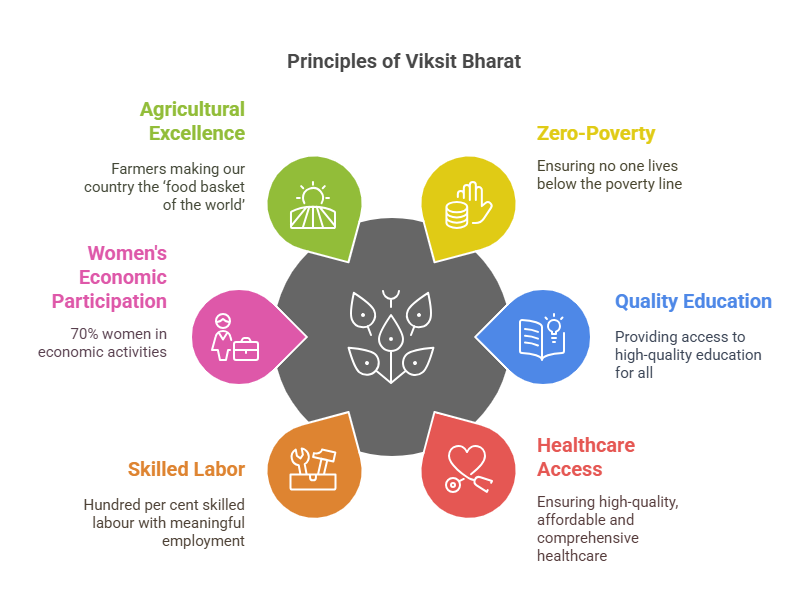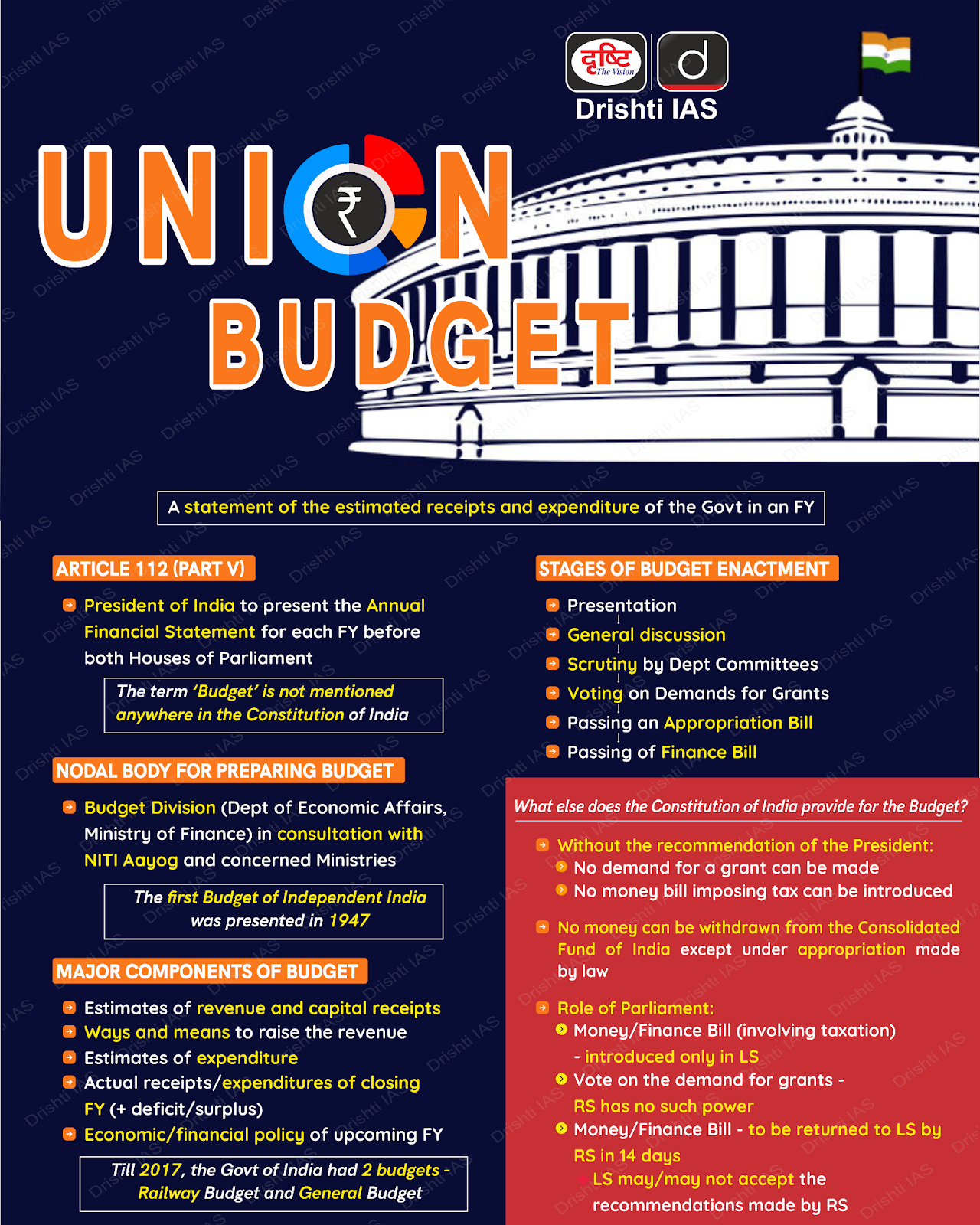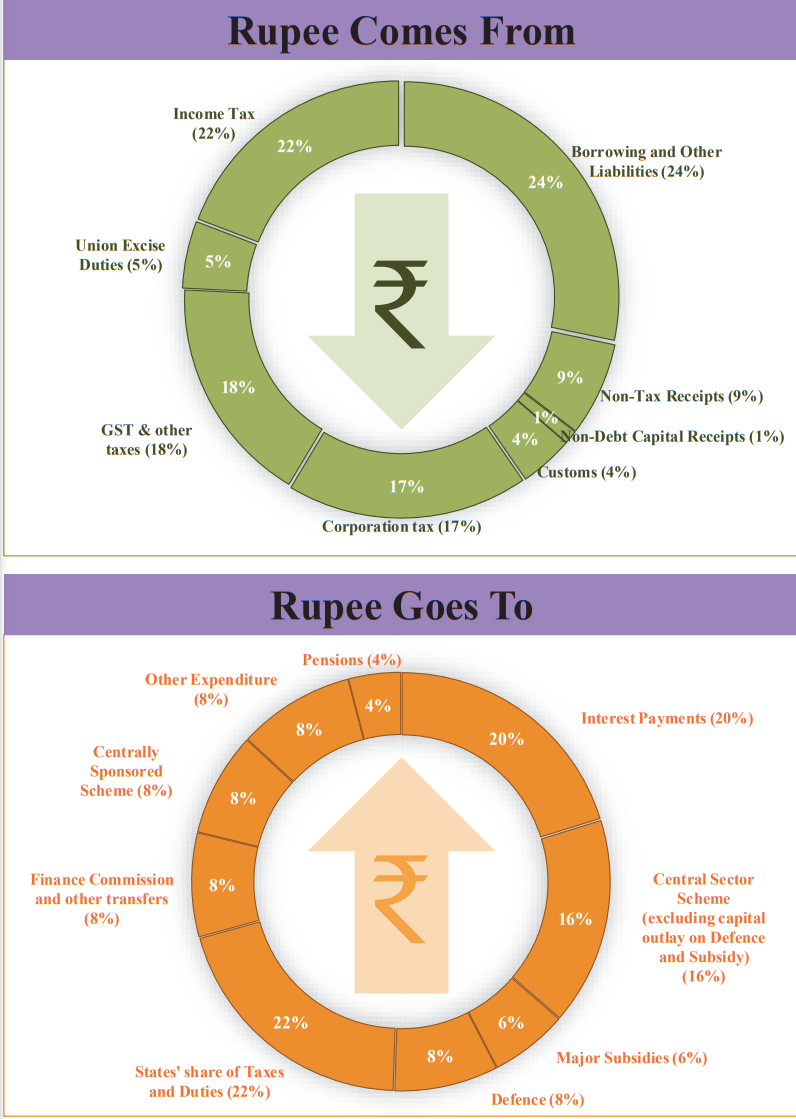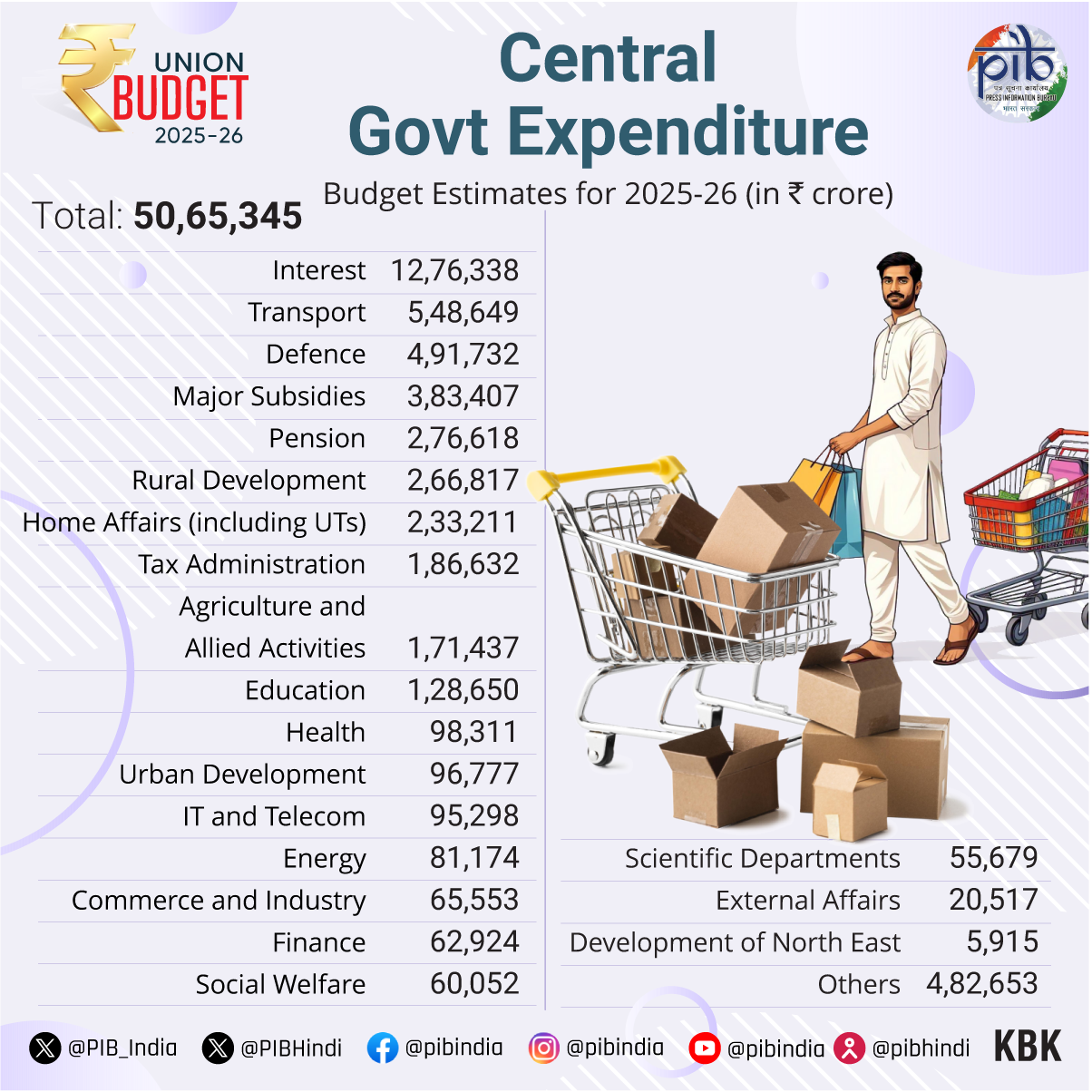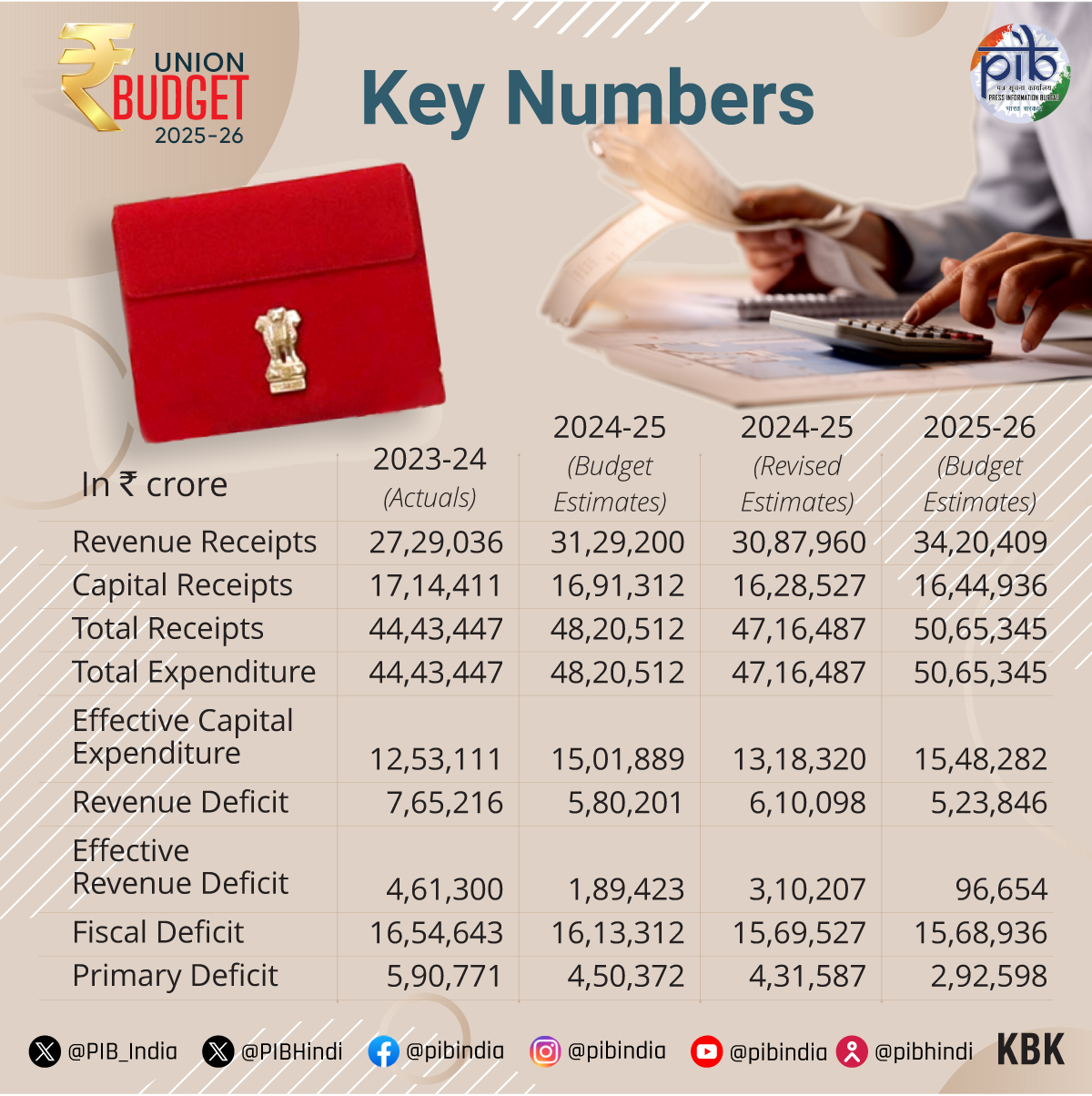Union Budget 2025-26 | 01 Feb 2025
|
For Prelims: Parliament, Makhana, Exclusive Economic Zone, Made in India, Small Modular Reactors (SMRs), Atomic Energy Act, Civil Liability for Nuclear Damage Act, UDAN scheme, Lithium-ion battery, UPI, e-Shram portal, PM Jan Arogya Yojana, NaBFID, Prime Minister Dhan-Dhaanya Krishi Yojana, Atma Nirbharta in Pulses, Revised MSME Classification, Urban Challenge Fund. For Mains: Significance of the Union Budget for resource allocation, Economic planning, Fiscal stability, Welfare schemes, and National development. |
Why in News?
The Union Budget 2025-26 was presented by the Union Finance Minister in the Parliament recognising 4 engines of development- agriculture, Micro, Small and Medium Enterprises (MSME),investment and exports.
- The Union Budget 2025-26, with the theme Sabka Vikas, aims to stimulate balanced growth across all regions.
- In line with the Budget theme, the Finance Minister outlined the broad principles of Viksit Bharat.
- The Budget proposes development measures focusing on the poor (Garib), Youth, farmers (Annadata) and women (Nari).
What are the 4 Engines of Development in the Union Budget 2025-26?
- 1st Engine- Agriculture:
- Prime Minister Dhan-Dhaanya Krishi Yojana: Announced to cover 100 low agricultural productivity districts, benefiting 1.7 crore farmers, enhancing irrigation, and post-harvest storage facilities.
- A ‘Rural Prosperity and Resilience’ programme will be launched with states to address agricultural underemployment through skilling, investment, and technology.
- Atma Nirbharta in Pulses: A 6-year mission focusing on Tur, Urad, and Masoor announced launched, ensuring climate-resilient seeds and remunerative prices.
- Central agencies (NAFED and NCCF) will be prepared to procure these 3 pulses from farmers over the next 4 years.
- Enhanced Kisan Credit Card (KCC) Limit: Raised from ₹3 lakh to ₹5 lakh to facilitate credit flow for 7.7 crore farmers.
- National Mission on High Yielding Seeds: To strengthen research, ensuring availability of 100+ high-yielding and pest-resistant seed varieties.
- Mission for Cotton Productivity: A 5-year initiative promoting sustainable farming, increasing extra-long staple cotton production, and improving quality.
- Makhana Board in Bihar: To be established to enhance production, processing, and value addition of Makhana.
- Comprehensive Program for Fruits and Vegetables: To promote efficient supply chains and ensure better market prices for farmers.
- Fisheries Development: New framework for sustainable fishing in the Indian Exclusive Economic Zone and High Seas, focusing on Andaman & Nicobar and Lakshadweep.
- Urea Plant in Assam: A new urea plant in the premises of Brahmaputra Valley Fertilizer Corporation Ltd (BVFCL) with 12.7 lakh metric ton capacity to boost agricultural productivity.
- Prime Minister Dhan-Dhaanya Krishi Yojana: Announced to cover 100 low agricultural productivity districts, benefiting 1.7 crore farmers, enhancing irrigation, and post-harvest storage facilities.
- 2nd Engine- MSMEs:
- Revised MSME Classification: Investment and turnover limits increased to 2.5 times, expanding credit opportunities for small businesses.
- Micro Enterprise Credit Cards: Rs 5 lakh credit facility for 10 lakh micro enterprises, promoting financial inclusion and economic participation.
- Credit Cover for MSMEs: Guarantee cover increased from ₹5 crore to ₹10 crore, enabling higher loan access.
- Focus Product Scheme for Leather and Footwear: Expected to generate 22 lakh jobs and ₹4 lakh crore turnover, and exports of over ₹ 1.1 lakh crore.
- Toy Sector Development: Clusters and innovation-based manufacturing fostering 'Made in India' brand in global markets.
- National Institute of Food Technology: A National Institute of Food Technology, Entrepreneurship and Management to be established in Bihar, promoting food processing, skilling, and entrepreneurship.
- Fund of Funds for Startups: To be established with an expanded scope and an additional contribution of ₹10,000 crore.
- 3rd Engine- Investment
- Urban Challenge Fund: ₹1 lakh crore allocated to support ‘Cities as Growth Hubs,’ ‘Creative Redevelopment of Cities,’ and ‘Water and Sanitation,’ with ₹10,000 crore allocated for 2025-26.
- Jal Jeevan Mission: With total budget outlay enhanced to Rs 67,000 Crore and extension till 2028, ensuring universal piped water coverage with enhanced funding for rural water projects.
- 15 crore households representing 80% of India’s rural population have benefitted by the mission.
- Maritime Development Fund: ₹25,000 crore fund (49% contribution by the Government), supporting long-term financing for shipbuilding, ports, and logistics infrastructure.
- Expansion of IITs: Additional infrastructure for 6,500 more students, boosting India’s technical education capacity.
- PM Research Fellowship: 10,000 fellowships for advanced research in IITs and IISc.
- Day Care Cancer Centers: To be set up in all district hospitals in the next 3 years, with 200 Centres in 2025-26, ensuring affordable cancer treatment accessibility.
- Bharatiya Bhasha Pustak Scheme: Digital Indian language books to enhance school and higher education accessibility.
- Nuclear Energy Mission for Viksit Bharat: To be set up with a ₹20,000 crore outlay for Small Modular Reactors (SMRs), with at least 5 indigenously developed SMRs operational by 2033.
- Amendments to the Atomic Energy Act and the Civil Liability for Nuclear Damage Act will be taken up for active partnership with the private sector.
- UDAN - Regional Connectivity Scheme: A revised UDAN scheme will enhance regional connectivity to 120 new destinations, aiming to carry 4 crore passengers over the next 10 years.
- It will also support helipads and smaller airports in hilly, aspirational, and North East regions.
- Greenfield Airport in Bihar: Greenfield airports will be developed in Bihar, alongside the expansion of Patna airport and a brownfield airport at Bihta (Patna).
- Western Koshi Canal ERM Project: Financial support for irrigation infrastructure in Mithilanchal, Bihar.
- Tourism for Employment-led Growth: The top 50 tourist destinations across the country will be developed in partnership with states through a challenge mode.
- 4th Engine- Export Promotion:
- Export Promotion Mission: It will be established, with sectoral and ministerial targets, led collaboratively by the Ministries of Commerce, MSME, and Finance.
- BharatTradeNet (BTN): A unified digital platform facilitating international trade documentation and financing solutions.
- National Framework for GCC: Policy incentives to promote outsourcing hubs (Global Capability Centres) in emerging Tier-2 cities.
- Warehousing Facility for Air Cargo: Development of storage infrastructure for high-value perishable exports.
What are Other Major Highlights of the Union Budget 2025-26?
- Taxation and Financial Reforms:
- Direct Taxes: No Income Tax for annual incomes up to ₹12 lakh, extended to ₹12.75 lakh for salaried taxpayers with deductions.
|
Income (in ₹) |
Tax Rate |
|---|---|
|
₹0 - ₹4 lakh |
Nil |
|
₹4 - ₹8 lakh |
5% |
|
₹8 - ₹12 lakh |
10% |
|
₹12 - ₹16 lakh |
15% |
|
₹16 - ₹20 lakh |
20% |
|
₹20 - ₹24 lakh |
25% |
|
Above ₹24 lakh |
30% |
- Tax Deducted at Source (TDS): TDS on Rent increased from ₹2.4 lakh to ₹6 lakh, reducing tax compliance burden.
- Tax Returns: Time limit for updated tax returns extended from 2 years to 4 years, facilitating voluntary tax compliance.
- Basic Customs Duty (BCD) Exemptions: 36 life-saving drugs for cancer, chronic, and rare diseases fully exempted from BCD.
- Lithium-ion battery manufacturing capital goods for EVs and mobile devices exempted to boost domestic production.
- Textile and electronics sector components exempted to encourage local manufacturing and reduce dependency on imports.
- Social Welfare and Inclusion:
- PM SVANidhi Scheme: UPI-linked credit cards with ₹30,000 limit for street vendors to enhance financial inclusion.
- Identity Cards for Gig Workers: Registration on e-Shram portal, ensuring social security and health benefits under PM Jan Arogya Yojana.
- 50,000 Atal Tinkering Labs: To be established in government schools in the next five years to promote innovation.
- Expansion of Medical Education: 10,000 new medical seats, targeting a total increase of 75,000 seats in five years.
- Financial Sector Reforms:
- Grameen Credit Score: A framework enabling SHG members and rural borrowers to access formal credit facilities more efficiently.
- Jan Vishwas Bill 2.0: Decriminalizing 100+ legal provisions, easing business operations and reducing regulatory compliance burdens.
- SWAMIH Fund 2.0: A ₹15,000 crore fund to complete 1 lakh more dwelling units, with contributions from the government, banks, and private investors.
- FDI in Insurance Sector: The FDI cap in the insurance sector will be increased from 74% to 100% for companies that invest the entire premium in India.
- Investment Friendliness Index of States: A new ranking framework for states to promote competitive cooperative federalism.
- Credit Enhancement Facility: NaBFID will establish a ‘Partial Credit Enhancement Facility’ to support corporate bonds for infrastructure.
- Pension Sector: A forum will be established for regulatory coordination and the development of pension products.
- High-Level Committee for Regulatory Reforms: A High-Level Committee will be formed to review all non-financial sector regulations, certifications, licenses, and permissions.
- Major Sources of Revenue and the Expenditure from the Budget:
- Major Central Govt Expenditure (Budget Estimates):
What are Financial Trends and Budgetary Estimates (2023-24 & 2024-25)?
- Receipts and Expenditure: In 2023-24, revenue receipts were ₹27.3 lakh crore, rising to ₹31.3 lakh crore (BE) for 2024-25.
- Effective capital expenditure fell from ₹17.1 lakh crore to ₹16.3 lakh crore (RE). Revenue expenditure increased from ₹34.9 lakh crore to ₹37.0 lakh crore (RE).
- Capital expenditure rose from ₹12.5 lakh crore to ₹15.0 lakh crore (BE) but was later revised to ₹13.2 lakh crore.
- Deficit Trends (as a percentage of GDP): The fiscal deficit was 3.3% in 2023-24, and the estimate for 2024-25 (RE) remains unchanged at 3.3%.
- The revenue deficit was 0.3% in 2023-24, which increased slightly to 0.8% in 2024-25 (RE).
- The effective revenue deficit in 2023-24 was 0.3%, and for 2024-25 (RE), it stood at 0.8%.
- Total Transfers to States & UTs: In 2023-24, the total transfers to States and Union Territories amounted to ₹20.65 lakh crore.
- This figure was revised to ₹22.76 lakh crore in 2024-25 (RE) and is projected to increase further to ₹25.60 lakh crore in 2025-26 (BE).
- Net Receipt of the Central Government: The net tax revenue collected by the Centre in 2024-25 (RE) was ₹28.4 lakh crore, while non-tax revenue stood at ₹5.8 lakh crore.
- Additionally, non-debt capital receipts, which include disinvestment proceeds and recoveries of loans, amounted to ₹0.8 lakh crore in 2024-25 (RE).
Conclusion
The Union Budget 2025-26, centered on the theme "Sabka Vikas," lays a strong foundation for Viksit Bharat by promoting inclusive growth, poverty eradication, quality education, and economic empowerment. By prioritizing youth, women, farmers, and the middle class, the Budget aims to stimulate sustainable development and private sector investment while ensuring social equity. If effectively implemented, these measures can accelerate India's transformation into a globally competitive and economically resilient nation.
Read more: Economic Survey 2024-25
|
Drishti Mains Question: Q. Assess how recent Union Budgets have managed the trade-off between fiscal discipline and economic stimulus through taxation, public spending, and deficit management. |
UPSC Civil Services Examination, Previous Year Question (PYQ)Prelims: Q1. What is the difference between “vote-on-account” and “Interim Budget”? (2011)
Which of the statements given above is/are correct? (a) 1 only Ans: (b) Q2. Along with the Budget, the Finance Minister also places other documents before the Parliament which include ‘The Macro Economic Framework Statement’. The aforesaid document is presented because this is mandated by (2020) (a) Long standing parliamentary convention Ans: (d) Mains:Q1. Distinguish between Capital Budget and Revenue Budget. Explain the components of both these Budgets. (2021) Q2. The public expenditure management is a challenge to the Government of India in the context of budget-making during the post-liberalization period. (2019) |

